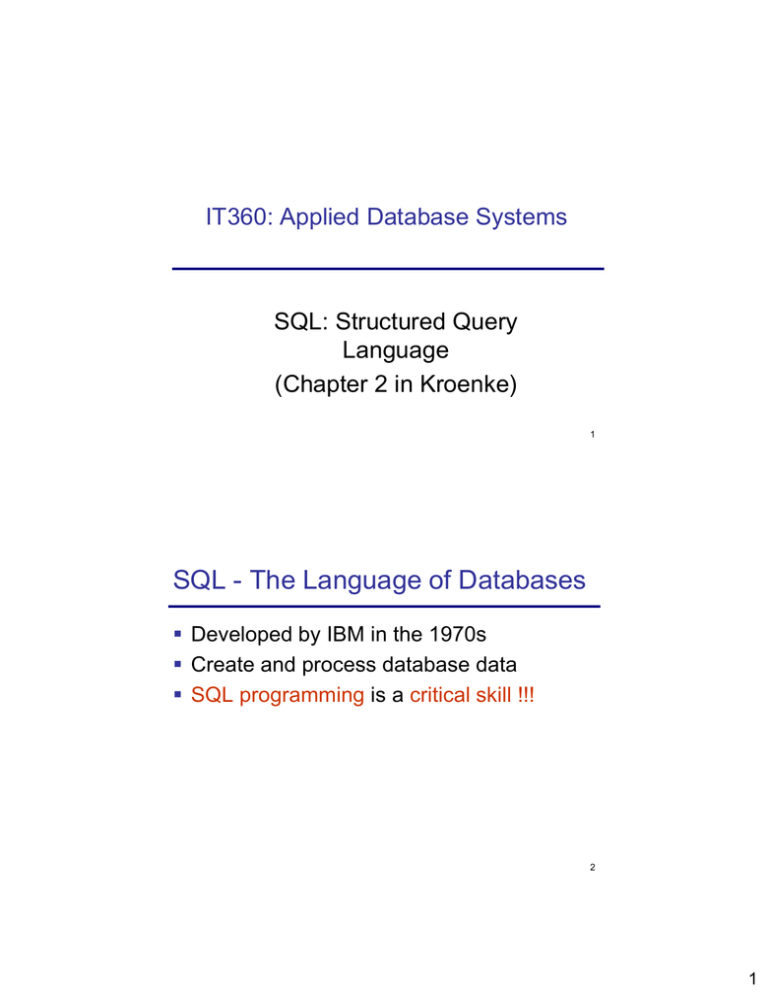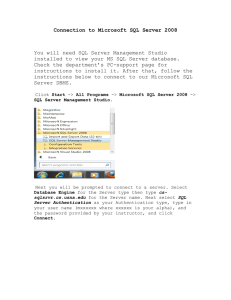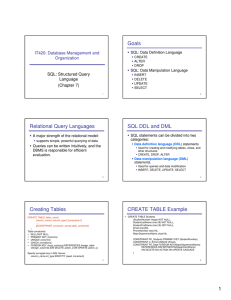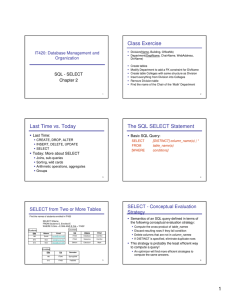SQL - The Language of Databases IT360: Applied Database Systems Language
advertisement

IT360: Applied Database Systems SQL: Structured Query Language (Chapter 2 in Kroenke) 1 SQL - The Language of Databases Developed by IBM in the 1970s Create and process database data SQL programming is a critical skill !!! 2 1 Facebook and Databases Relational databases are accessed in much the same way across the board: SQL. Learning how SQL works is crucial to getting anything done in databases, and any GUI is largely a wrapper around the SQL statements one uses to make those actions happen. Knowing a little about database design (layout, B-trees, file storage, normalization) is good, mostly for helping you understand good queries. We run the LAMP stack here, so we primarily use MySQL databases across the site. I hope this helps a little. Another good motivation may be found in the requirements for most engineering positions here on http://www.facebook.com ;) Thanks! Nick from Facebook (a few years ago) 3 Relational Query Languages A major strength of the relational model: supports simple, powerful querying of data Ad-hoc queries High-level (declarative) languages Queries can be written intuitively DBMS is responsible for efficient evaluation. 4 2 SQL DDL and DML SQL statements can be divided into two categories: Data definition language (DDL) statements Used for creating and modifying tables, views, and other structures CREATE, DROP, ALTER Data manipulation language (DML) statements. Used for queries and data modification INSERT, DELETE, UPDATE, SELECT 5 The SQL SELECT Statement Basic SQL Query: SELECT FROM [WHERE [DISTINCT] column_name(s) | * table_name(s) conditions] 6 3 Selecting All Columns: The Asterisk (*) Keyword SELECT * FROM Students; Student Student Student Number LastName FirstName Email PhoneNumber MajDeptName 410-431-3456 ComSci 190 Smith John jsmith@usna.edu 673 Doe Jane jdoe@usna.edu 312 Doe Jane jdoe2@usna.edu ComSci 443-451-7865 Math 7 Specific Columns and Rows from One Table SELECT StudentNumber, StudentLastName, StudentFirstName FROM Students WHERE MajDeptName = ‘ComSci’; Student Student Number LastName Student FirstName 190 Smith John 673 Doe Jane 8 4 The DISTINCT Keyword SELECT SELECT DISTINCT StudentLastName StudentLastName FROM Students; FROM Students; StudentLastName StudentLastName Smith Doe Smith Doe Doe 9 Class Exercise Department(DeptName, ChairName, WebAddress, DivName) Find the name of the Chair of the ‘Math’ Department 10 5 WHERE Clause Options AND, OR IN, NOT IN, BETWEEN LIKE SELECT SNb, SName FROM Students WHERE SNb LIKE ’12%’ AND Major IN (‘SIT’, ‘SCS’) Wild cards: SQL-92 Standard (SQL Server, Oracle, etc.): _ = Exactly one character % = Any set of characters (zero or more) MS Access ? * = Exactly one character = Any set of characters (zero or more) Example: Students(SNb, SName, Email, Major) Find alpha and name of SCS or SIT students with SNb starting with ‘12’ 11 Sorting the Results SELECT [DISTINCT] column_name(s) | * FROM table_name(s) [WHERE conditions] [ORDER BY column_name(s) [ASC/DESC]] Example: Students(SNb, SName, Email, Major) SELECT SNb, SName FROM Students ORDER BY SName ASC, SNb DESC 12 6 Summary (partial) SELECT [DISTINCT] column_name(s) FROM table_name WHERE conditions ORDER BY column_name(s) [ASC/DESC] 13 7









